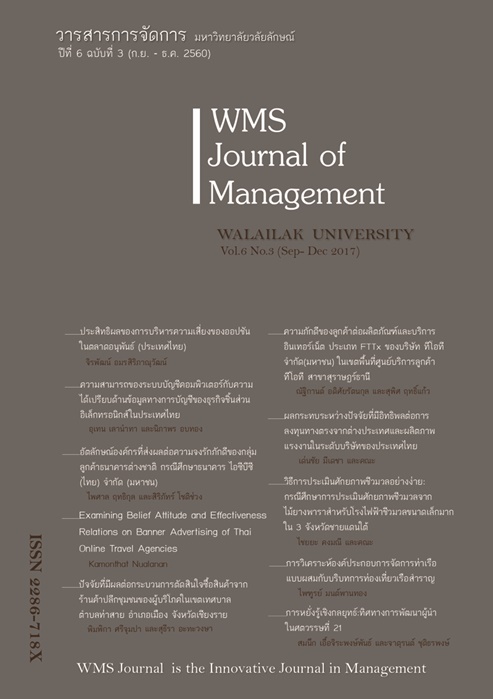A Simple Method of Potential Biomass Feasibility: A Case Study of Potential Rubberwood Biomass Feasibility as Feedstock for a Very Small Biomass Power Plant in the Three Southern Border Provinces
Main Article Content
Abstract
Article Details
References
กรมพัฒนาพลังงานทดแทนและอนุรักษ์พลังงาน กระทรวงพลังงาน. (2557). รายงานพลังงานทดแทนของประเทศไทย 2557. กรุงเทพฯ: กรมพัฒนาพลังงานทดแทนและอนุรักษ์พลังงาน กระทรวงพลังงาน.
กรมพัฒนาพลังงานทดแทนและอนุรักษ์พลังงาน. (2558). ศักยภาพชีวมวลในประเทศไทย. สืบค้นเมื่อ 17 เมษายน 2559, สืบค้นจาก http://www.dede.go. th/dede/index.php?option=com_content&view=article&id=130%3A2010-05-07-08-10-57&catid=58&Itemid=68&lang=th
การไฟฟ้าส่วนภูมิภาค. (2552). การกำหนดส่วนเพิ่มราคารับซื้อไฟฟ้าสำหรับผู้ผลิตไฟฟ้าขนาดเล็กมากจากพลังงานหมุนเวียน. สืบค้นเมื่อ 13 เมษายน 2559, สืบค้นจาก http://www.pea.co.th /vspp/Documents/VSPP/Adder19082552.pdf
เกรียงศักดิ์ รองเดช. (2551). สิ่งจูงใจต่อการตัดสินใจปลูกยางพาราของเกษตรกรอำเภอเชียงของ จังหวัดเชียงราย. วิทยานิพนธ์ปริญญามหาบัณฑิต, มหาวิทยาลัยเชียงใหม่.
ชูลีรัตน์ คงเรือง, ปราณี หนูทองแก้ว, จอมภพ แววศักดิ์ และสุภวรรณ ฏิระวณิชย์กุล.
(2554). การวิเคราะห์ทางเศรษฐศาสตร์ของโรงไฟฟ้าแก๊สชีวมวลขนาด 100 kW. วารสารมหาวิทยาลัยทักษิณ, 14(2), 76-84.
ณัฏฐ์สิริ ลักษณะอารีย์. (2555). การศึกษาความเป็นไปได้ทางการเงินของโรงไฟฟ้าชีวมวลขนาดเล็กมากในจังหวัดประจวบคีรีขันธ์. วารสารเกษมบัณฑิต, 13(2), 28-40.
บุษบา พฤกษาพันธุ์รัตน์, บุญรอด สัจจกุลนุกิจ, วุฒินันท์ นุ่นแก้ว, ธนวัฒน์ ศรีพนมวรรณ และชัยวัฒน์ ทานะรมณ์. (2555). แนวทางการส่งเสริมมาตรฐานเชื้อเพลิงชีวมวลแปรรูปในภาคอุตสาหกรรม. กรุงเทพฯ: สำนักงานกองทุนสนับสนุนการวิจัย.
พิศาล บุญเอี่ยมศรี. (2553). การใช้ชีวมวลเป็นเชื้อเพลิง. Engineering Today, 8(88), 69-71.
วราฤทธิ์ ชำนิจ. (2555). ปัจจัยในการตัดสินใจเลือกทำเลที่ตั้งโรงไฟฟ้าชีวมวลของผู้ประกอบการในประเทศไทย. วิทยานิพนธ์ปริญญามหาบัณฑิต, มหาวิทยาลัยเกษตรศาสตร์.
ศูนย์ส่งเสริมพลังงานชีวมวล มูลนิธิพลังงานเพื่อสิ่งแวดล้อม. (2549). ชีวมวล. กรุงเทพฯ: ศูนย์ส่งเสริมพลังงานชีวมวล มูลนิธิพลังงานเพื่อสิ่งแวดล้อม.
ศูนย์สารสนเทศการเกษตร สำนักงานเศรษฐกิจการเกษตร. (2559). ยางพารา: เนื้อที่ยืนต้น เนื้อที่กรีดได้ ผลผลิต และผลผลิตต่อไร่ปี 2542-2558. (เอกสารไม่ตีพิมพ์).
สมาคมธุรกิจไม้ยางพาราไทย. (2558). ปริมาณชีวมวลจากไม้ยางพาราในพื้นที่ตัดโค่นยางพารา. (เอกสารไม่ตีพิมพ์).
สาวิตรี การีเวทย์. (2553). การทบทวนและวิเคราะห์เชิงเปรียบเทียบผลงานวิจัยด้านการประเมินศักยภาพแหล่งพลังงานชีวมวล. กรุงเทพฯ: สำนักงานกองทุนสนับสนุนการวิจัย.
สุธีระ ประเสริฐสรรพ์. (2545). การศึกษาศักยภาพเชิงพื้นที่ของชีวมวลไม้ยางพาราในภาคใต้เพื่อการผลิตพลังงาน. กรุงเทพฯ: สำนักงานพัฒนาวิทยาศาสตร์และเทคโนโลยีแห่งชาติ.
สำนักงานนโยบายและแผนพลังงาน กระทรวงพลังงาน. (2558). รายงานสถิติพลังงานของประเทศไทย 2558. กรุงเทพฯ: สำนักงานนโยบายและแผนพลังงาน กระทรวงพลังงาน.
เอกพงษ์ หนูพลับ. (2545). ปัจจัยบางประการที่มีอิทธิพลต่อการปลูกยางพาราของเกษตรกรในอำเภอบ้านกรวด จังหวัดบุรีรัมย์. วิทยานิพนธ์ปริญญามหาบัณฑิต, มหาวิทยาลัยสุโขทัยธรรมาธิราช.
Gujba, H., Mulugetta, Y., & Azapagic, A. (2010). Environmental and economic appraisal of powergeneration capacity expansion plan in Nigeria. Energy Policy, 38(10), 5636-5652.
Ratnasingam, J., Ramasamy, G., Ioras, F., Kaner, J., & Wenming, L. (2012). Production potential of rubberwood in Malaysia: Its economic challenges. Notulae Botanicae Horti Agrobotanici Cluj-Napoca, 40(2), 317-322.
Ratnasingam, J., Ramasamy, G., Wai, L. T., Senin, A. L., & Muttiah, N. (2015). The prospects of rubberwood biomass energy production in Malaysia. Bioresources, 10(2), 2526-2548.


